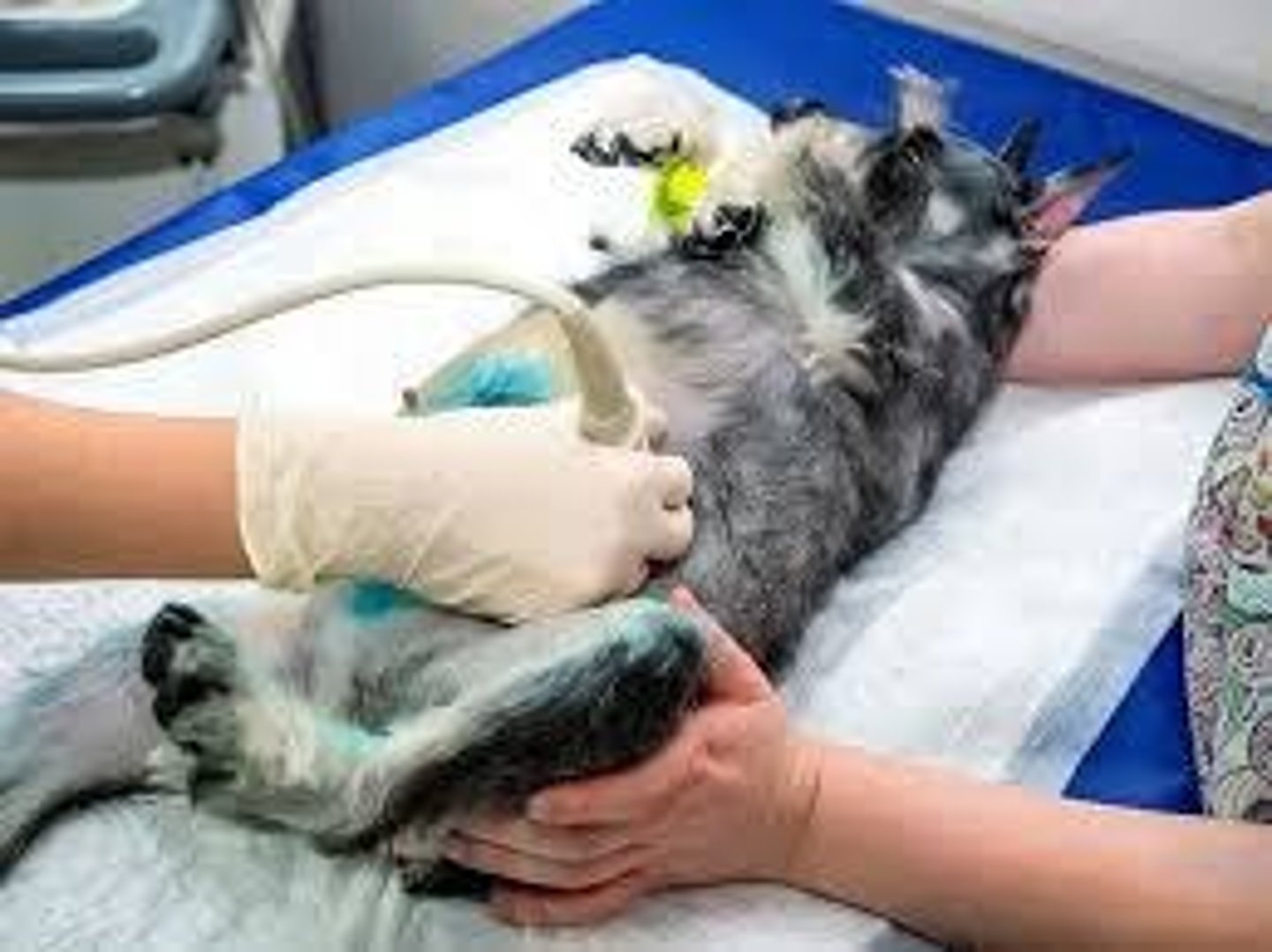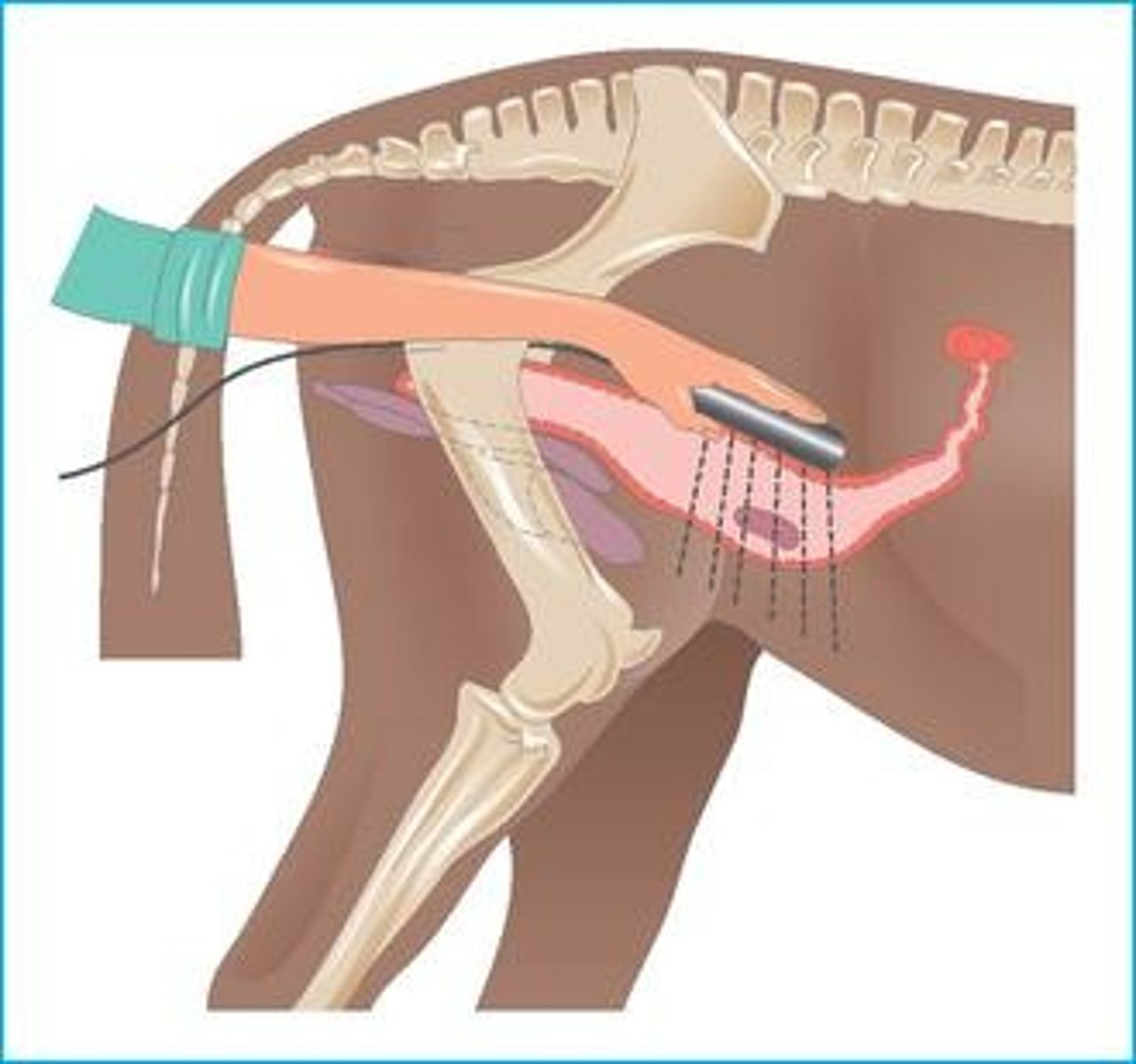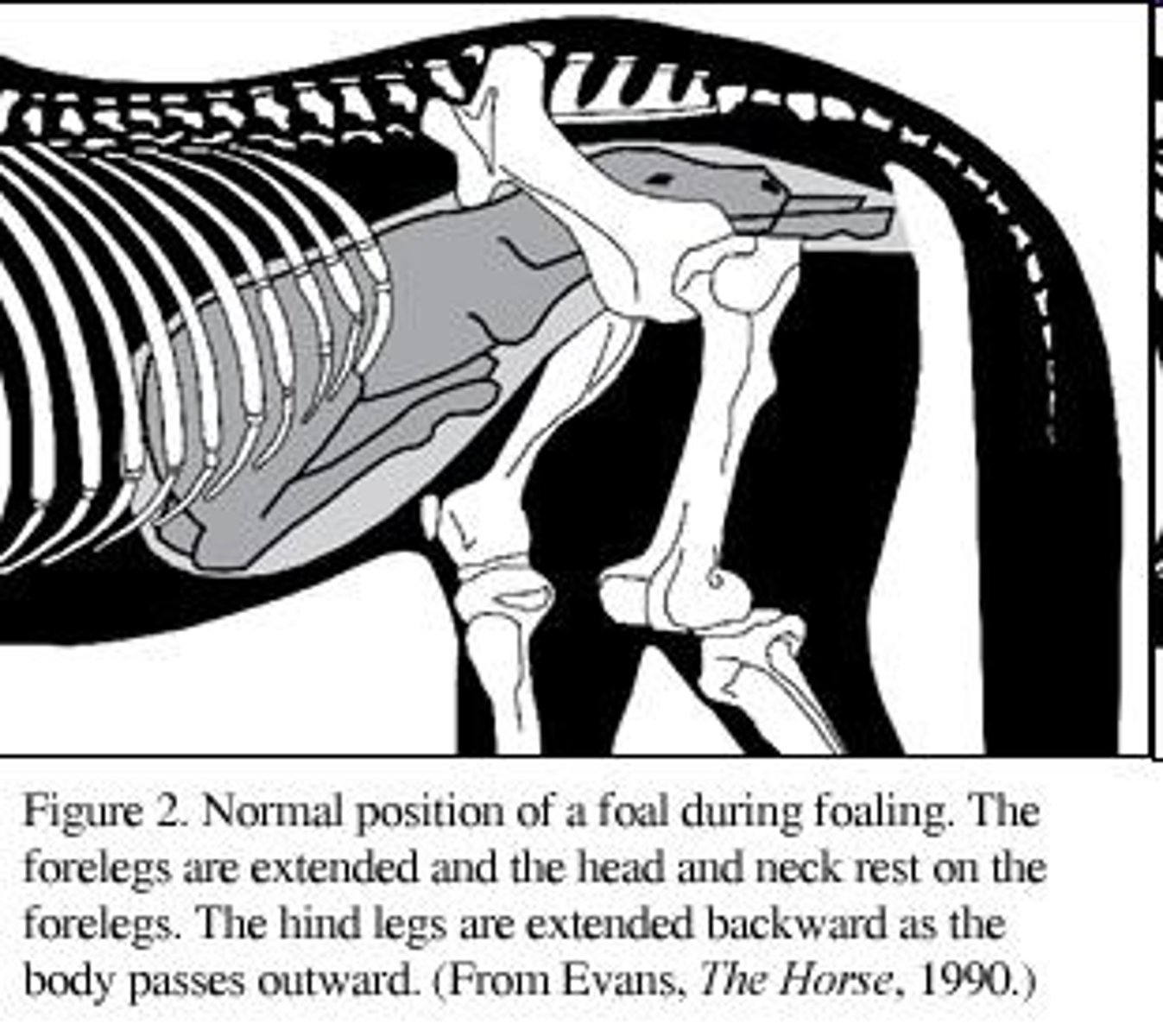Pregnancy Diagnosis and Parturition
1/85
There's no tags or description
Looks like no tags are added yet.
Name | Mastery | Learn | Test | Matching | Spaced |
|---|
No study sessions yet.
86 Terms
Copulation
Sexual intercourse.
Insemination
The introduction of semen into a female animal by natural or artificial means.
Pregnancy
The condition of being pregnant.
Gestation
The process or period of developing inside the womb between conception and birth.
Gestation period
The amount of time an offspring is carried within the body.
Gravid
Another word to describe an animal which is pregnant (gravis = heavy).
Pseudopregnancy
False/phantom; behaviours and physical signs without being pregnant.
Parturition
The action or process of giving birth.
Conception
The fertilization of an egg by a sperm.
Gestation period in dogs
Around 63 days (57-72 days).
Gestation period in cats
Around 63-65 days (60-67 days).
Superfecundation
More than one father across a litter of kittens.
Early birth effects
If an animal gives birth too early, then the chance of survival for offspring decreases rapidly.
Factors causing early birth
Stress, infection, injury, hormones.
Physical observation
One of the ways to diagnose pregnancy.
Hormone assay
A method to diagnose pregnancy through hormone levels.
Ultrasound scan
A diagnostic tool used to determine pregnancy.

Pseudopregnancy in cats
Less common than in dogs.
Mismating
An unplanned mating.
Maternal care
The level of care a mother provides to her offspring.
Semelparous
Species that reproduce only once in their lifetime.
Iteroparous
Species that can reproduce multiple times throughout their life.
Monotocous
Species that typically give birth to one offspring at a time.
Polytocous
Species that typically give birth to multiple offspring at a time.
Abdominal palpation
A method used 21-28 days post mating to detect pregnancy by feeling for small 'golf balls', although it is not very reliable due to false positives and negatives.
Ultrasonography
A technique to identify vesicles from 17 days (1-2mm) but clearer at day 21 and beyond (3mm), with less accuracy in larger litters or later in gestation.
Behavioural changes
Changes in behaviour that may indicate pregnancy, prompting further investigation if mating has not been witnessed.
Radiography
A diagnostic method suitable post day 47 when foetal skeletons are visible, though accuracy may decrease in large litters.
Relaxin assay
A test that detects the reproductive hormone relaxin, which rises after conception and can be detected from around day 21, with peak concentrations in dogs at 42-56 days.
Natural resorption
A process where early diagnosis may not reflect the number of offspring born, as the foetus does not leave the body as in a miscarriage.
Management of non-pregnant animals
Important for flock/herd management to minimize rates of 'empty' (pigs/cows), 'yeld' (sheep), or barren animals.
Culling
The end point for animals that cannot achieve or maintain pregnancy, often due to reproductive failure.
Barren ewe rate
The percentage of ewes that do not become pregnant, with an industry target of 2% after lambing.
Neonatal lamb disease
A major factor affecting flock productivity, along with toxoplasmosis and enzootic abortion.
Mating mark harnesses
Devices used to indicate if a tup (ram) is working, requiring proper fit and regular color changes to avoid marking during pre-copulation.
Ultrasound scanning in sheep
A method usually completed between 45-90 days of gestation to detect pregnancy and assess foetal numbers.

Foetal nutrition management
Ultrasound can help support nutrition requirements by grouping ewes according to foetal numbers.
Artificial rearing planning
Planning for artificial rearing if necessary based on the number of foetuses detected.
Delayed implantation
A reproductive strategy in some animals where fertilization occurs but the embryo does not implant immediately.
Embryonic diapause
A phenomenon where the development of the embryo is temporarily paused.
Toxoplasmosis
An infection that can affect reproductive outcomes in sheep.
Enzootic abortion
A disease that can lead to reproductive failure in sheep, impacting flock productivity.
Industry targets
Specific benchmarks set for barren animal rates per species to ensure optimal productivity.
MSD findings
Research indicating that 30% of GB sheep flocks were unaware of their barren ewe rate or reported rates higher than 5% after lambing.
Oestrus
The period when pigs return to heat after 18—22 days if not pregnant.
Ultrasound scanning in pigs
Can occur 21-25 days after copulation if pigs do not appear to have returned to oestrus.

Rectal palpation in pigs
Can occur after day 30 (>60 days) to check for pregnancy.
KMAR HeatmountTM Detector
A device that ruptures a chamber when a pig is mounted.
Pregnancy diagnosis in cattle
Involves checking for non-return to oestrus and measuring milk progesterone 24 days after service.
Milk progesterone measurement in cattle
>95% of cows with low progesterone are not pregnant, and 20-25% with high progesterone are not pregnant.
Pregnancy associated glycoproteins
Can be measured 28 days after service to detect foetal glycoproteins in blood or milk.
Transrectal examination in cattle
Can detect foetus and ovarian structures from 20 days but is not reliable until ~35 days.
Ultrasound in cattle
Can be performed from 26 days, with better accuracy at ~40 days, and is >95% accurate.

Pregnancy diagnosis in horses
Includes checking return to oestrus, rectal palpation, ultrasound scanning, and hormone tests.
PMSG
Pregnant mare serum gonadotropin, detectable in blood from day 45-100.

eCG
Equine chorionic gonadotropin, detectable in blood from day 45-100.
Pregnancy duration
Animals are pregnant for a specific period, balancing between offspring and mother.
Parturition preparation
In late gestation, oestrogen becomes dominant, promoting uterine muscle development and relaxation.
Adrenocorticotropic hormone (ACTH)
Increases foetal adrenal cortical glucocorticoids affecting the placenta and uterus.
Parturition stages
Includes three stages: uterine contractions, delivery of the foetus, and delivery of the placenta.
Stage one of labour
Uterine contractions force the foetus and membranes to the cervix; duration varies by species.
Stage two of labour
Delivery of the foetus, which can take 15-30 minutes in a foal.
Stage three of labour
Delivery of the placenta, which can take a few hours; delayed delivery requires intervention.
Positioning; single foetus
Normal is anterior presentation (diving position) although in cattle posterior presentation is common (also considered normal).
Positioning; litter (multiple)
In pigs, dogs, and cats, anterior and posterior presentations are equally common and not problematic. In sheep, the first is usually anterior; other positions or simultaneous presentation of more than one is a problem.

Retained membranes
If the membranes are retained for more than 10hrs then veterinary attention is likely required; as well as if dystocia (difficult birth) is seen.
Dystocia
Difficult birth caused by various factors including feto-maternal disproportion, malpresentation, foetal monsters, uterine inertia/torsion/rupture.
Force of contractions
Means foal can die soon if they become stuck or are malpresented; long limbs can be difficult to reposition.
Interventions for dystocia
Manual manipulation, caesarean section, oxytocin.
Post-partum mare problems
Include perineal or vaginal lacerations, retained placenta, retained foetus, uterine prolapse, uterine haemorrhage, metritis, mastitis.
Calving Problems
Similar to foaling, more interventions required although resilient to delay and dystocia.
Calving jack
Commonly used to aid delivery after correcting malpresentation and in cases of maternal fatigue or uterine inertia.
Reasons for caesarean in calving
Foetal oversize, incomplete cervical dilation, irreducible uterine torsion, foetal deformities, irreducible malpresentation, hydro-allantois (increased fluid in allantoic sac).
Farrowing
Pigs and other animals which give birth to litters generally require fewer interventions than those species that give birth to one (or two) larger offspring.
Pre-birth behaviours in farrowing
Include reduced appetite, chewing on bedding, and failure to settle.
Problems in farrowing
Can include uterine inertia, large foetus blocking cervix, small gilt, malpresentation, two foetuses presenting simultaneously, dead foetus(es).
Caesarean section in farrowing
Can result from uterine inertia, foetus being out of reach and after dystocia (foetal oversize, malpresentation etc.).
Lambing
Ewes can produce between 1-4 lambs either indoors or outdoors (depending on breed) with most producing them without assistance.
Stage one of lambing
Ewe will separate from the main group; abdominal contractions (15-30 seconds at intervals of 15 minutes before moving to be 2-3 minutes apart); mucus and water bag appear.
Stage two of lambing
Rupture of allanto-chorion (bag); amnion and foetus in birth canal; contractions every few minutes with parts of the lamb becoming visible.
Stage three of lambing
Expulsion of membranes within 2-3 hours of the last lamb; longer = investigation.
Lambing Problems
Many problems can arise at lambing; multiple presenting together, feto-maternal disproportion (big lamb), malpresentation, uterine inertia, uterine torsion, uterine rupture.
Reasons for intervention in lambing
Trying to lamb for more than one hour, interval between bag breaking and lamb, lamb visible but no progress made (20 min), contractions but no lamb progress made.
Signs of lambing intervention
Starting to lamb but then stopping, legs only out/head and one leg out/tail out, lamb is large and obviously stuck, parts of two different lambs can be seen.
Brown or smelly discharge
Noted as a sign of decomposed lamb.
Vaginal prolapse
A condition that may necessitate intervention during lambing.